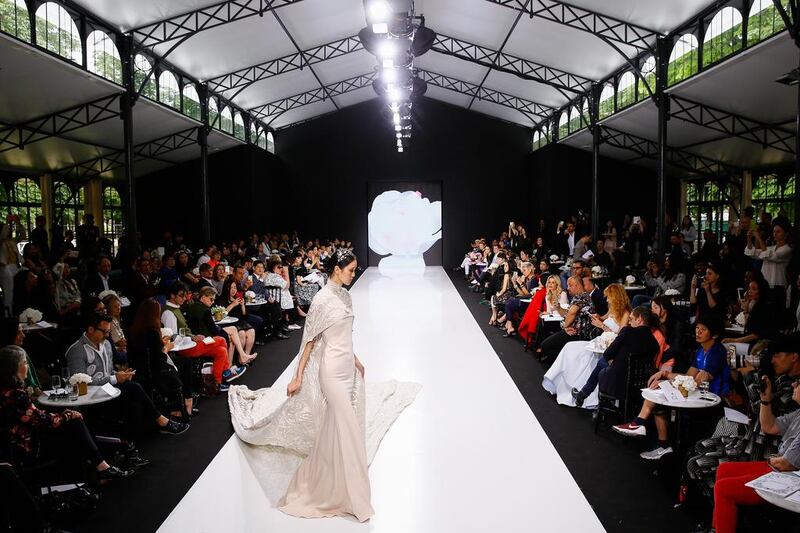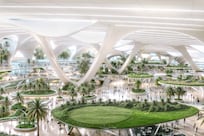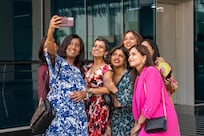It has been a frenetic few months in the fashion world. The new season started last month with New York Fashion Week, followed by the other “big four” shows in London, Milan and Paris.
Closer to home, we had the recently concluded Fashion Forward Dubai. Although it is not nearly on the same scale as the big four, season eight of the event wrapped to the praise of most critics, with home-grown ready-to-wear and couture designers showing off their creations at Dubai’s Design District (d3) earlier this week.
The punishing schedule of fashion weeks means there is little respite for designers and buyers. Not only do womenswear and menswear prêt-à-porter shows take place twice a year in New York, London, Milan and Paris, but now cities from Kiev to Tokyo also want a slice of the style pie. Then there is haute couture week in Paris and numerous other city-specific additions, from resort/cruise and pre-autumn shows to bridal presentations.
It all adds up to a huge amount of effort and expense, with a lot riding on how the creations are received. Consultancy Bain & Company estimated the global personal luxury-goods market to be worth more than €250 billion (Dh999.8bn) last year, with sales in Dubai alone worth €3bn.
The tricky job of predicting which designs we will want to wear, months in advance of the new seasons, falls on senior buyers for leading retailers.
“What I’m looking for is instant appeal,” says London-based Bridget Cosgrave, fashion and buying director for the Boutique 1 group, which has stores in the United Kingdom, UAE and Lebanon. “Nobody needs anything, really – it has to create an immediate and burning desire, which will translate into what I call an emotional purchase. Quality and fit are also a must.”
In the UAE, home-grown events help to establish a unified domestic and regional platform for designers to showcase their wares. As a country that will celebrate its 45th birthday on December 2, the UAE isn’t expected to compete with stalwart fashion weeks such as New York, which was the first to emerge, in 1943. In fact, several attempts to establish local events on such a scale have been short lived, due to organisational challenges and a lack of sponsorship.
The ill-fated Fashion Week Middle East stumbled onto the scene in 2014, for example, and was never heard of again, after leaving frustrated audiences in its wake due to unforgivably late-running shows and designer no-shows.
Yet the UAE continues to forge ahead. This month it was announced that Dubai Fashion Week, which was launched in 2006 and shelved in 2011, will return next year. The showcase of seasonal, ready-to-wear collections by regional designers will be held under the patronage of Sheikha Hend Al Qassemi, editor-in-chief of Velvet Magazine and author of The Black Book of Arabia. The revamped event is expected to be held twice a year, in March and October.
The standout local event remains Fashion Forward Dubai. Launched in 2013 under the careful curation of its founder, Bong Guerrero, it quickly established itself as one of the best-executed industry events in town. It routinely attracts celebrated UAE and regional designers – including Furne One and Sheikha Madiyah Al Sharqi – not to mention renowned keynote speakers such as the former executive director of the Council of Fashion Designers of America, Fern Mallis.
Another fashion fixture gaining traction in Dubai is Huawei Arab Fashion Week. Launched three seasons ago, the most recent event ran from October 6 to 10.
Developed and supported by the Arab Fashion Council, HAFW stands alone as a celebration of “ready couture” and successfully shows pieces from industry heavyweights such as Rad Hourani alongside emerging designers such as Lamya Abedin.
In this highly competitive market, where malls from Abu Dhabi to Sharjah are also hosting their own occasional shopping festivals and high-street label runway shows, it pays to stand out.
“I know who we are, and this is an open market,” says Arab Fashion Council board member Mahmood Al Farsi. “Anyone who wants to organise a fashion event is welcome to – the more the merrier. All we can do is continue to provide the best support for Emirati and GCC designers to succeed and be recognised around the world.”
While emerging designers might have ambitions to show at regional fashion events, time and financial considerations weigh heavy. Such concerns also apply to established couturiers, such as Dubai-based Michael Cinco.
His collections of hand-finished gowns – which have been worn by stars including Lady Gaga, Rihanna and Mila Kunis – take on average six months to make, and the prices run into the hundreds of thousands of dirhams.
Since establishing his eponymous label in 2003, Cinco has participated in events such as Fashion Forward in recent years. In July, he made his debut at Paris Haute Couture Week.
“I like to showcase here in Dubai but my aim is to go global,” says Cinco. “It’s been good for me to venture outside my comfort zone and now, because most of my clients are from Russia and the US, it’s important for me to show abroad.
“Naturally, it’s more stressful and expensive to show abroad. In Paris, for example, you must bring your entire team and arrange everything yourself, down to the tent. An obvious advantage of Dubai is everything is ready to go – you almost just show up.”
Only the strongest survive in the fast-paced, demanding fashion industry, says Cinco.
“I’m so grateful for everything and this is my passion, but sometimes it can be creatively draining to keep producing so many seasons in a year,” he adds.
It is a sentiment shared by creative directors of leading Italian and French houses, who recently complained about the relentless pressure to deliver six new, dynamic collections in 12 months.
Cinco believes that reducing or consolidating the calendar would help and go some way to seeing off the looming threat posed by high-street brands.
“Competition from stores such as Zara and H&M is killing the market,” he says. “Their teams will watch a designer’s show for spring-summer during the winter, and before we’ve had a chance to sell our collections, similar ideas and designs are in their stores.
“A lot is changing, but one thing is for sure, consumers want the collections now, not in six month’s time.”
rduane@thenational.ae





